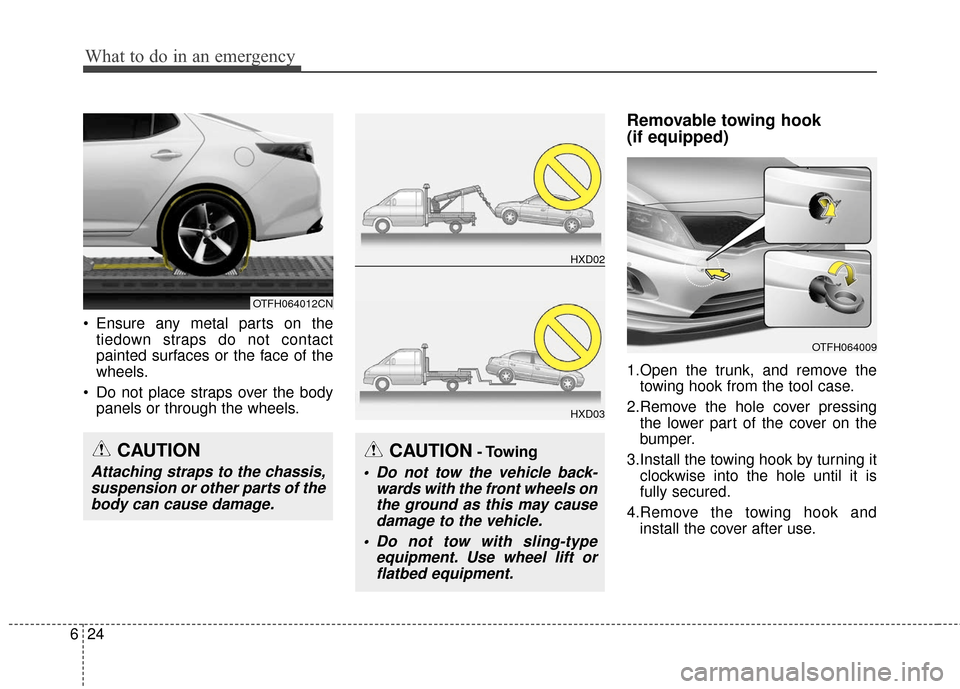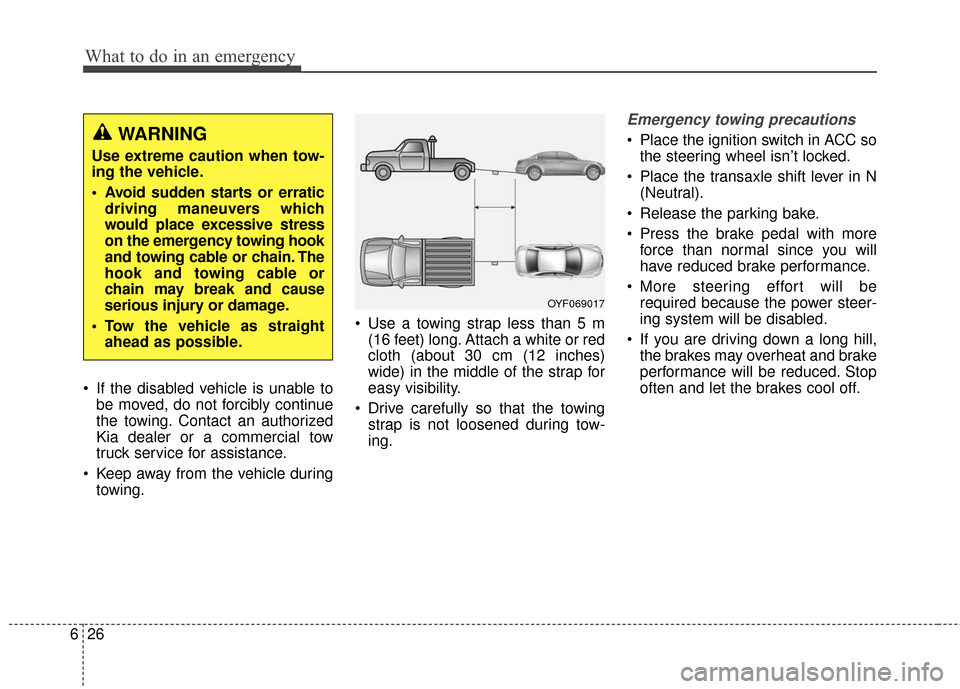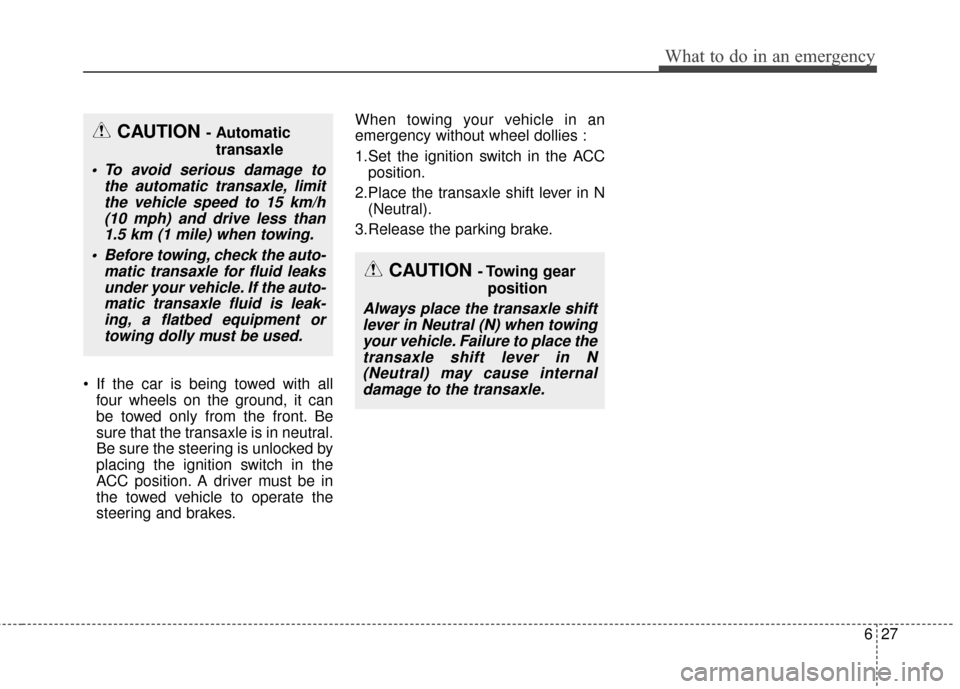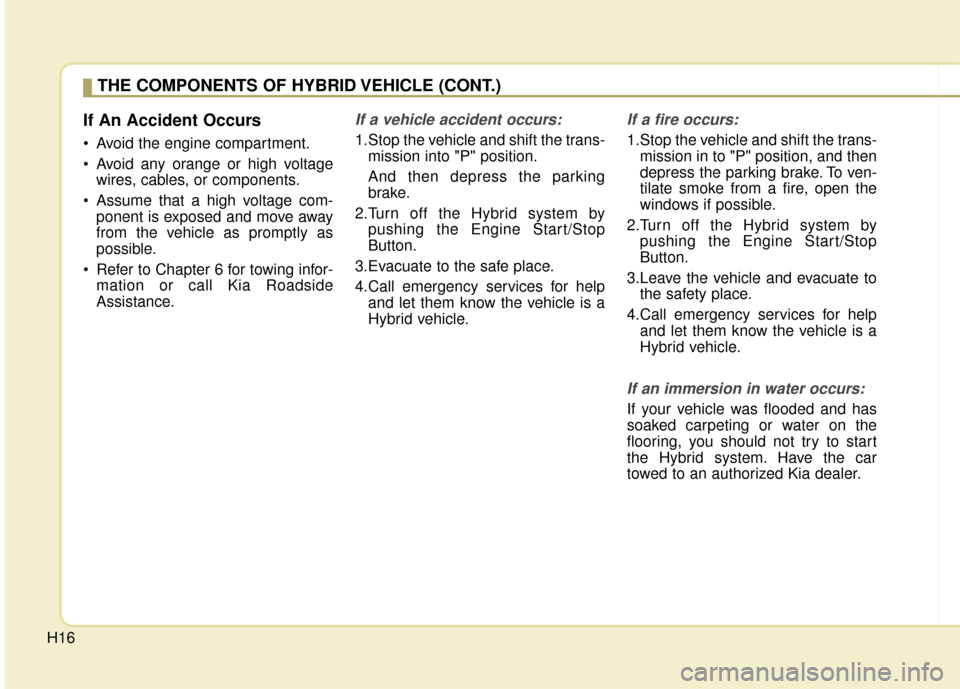2016 KIA Optima Hybrid towing
[x] Cancel search: towingPage 337 of 466

What to do in an emergency
24
6
Ensure any metal parts on the
tiedown straps do not contact
painted surfaces or the face of the
wheels.
Do not place straps over the body panels or through the wheels.
Removable towing hook
(if equipped)
1.Open the trunk, and remove thetowing hook from the tool case.
2.Remove the hole cover pressing the lower part of the cover on the
bumper.
3.Install the towing hook by turning it clockwise into the hole until it is
fully secured.
4.Remove the towing hook and install the cover after use.
CAUTION- Towing
Do not tow the vehicle back- wards with the front wheels onthe ground as this may causedamage to the vehicle.
Do not tow with sling-type equipment. Use wheel lift orflatbed equipment.
HXD02
HXD03
OTFH064009
CAUTION
Attaching straps to the chassis,suspension or other parts of thebody can cause damage.
OTFH064012CN
Page 338 of 466

625
What to do in an emergency
Emergency towing
If towing is necessary, have it
done by an authorized Kia dealer
or a commercial tow truck service.If towing service is not available in an
emergency, your vehicle may be
temporarily towed using a cable or
chain secured to the emergency tow-
ing hook under the rear of the vehi-
cle. Use extreme caution when tow-
ing the vehicle. A driver must be in
the vehicle to steer it and operate the
brakes.
Towing in this manner may be done
only on hard-surfaced roads for a
short distance and at low speeds.
Also, the wheels, axles, power train,
steering and brakes must all be in
good condition.
Do not use the tow hooks to pull a
vehicle out of mud, sand or other
conditions from which the vehicle
cannot be driven out under its own
power.
Avoid towing a vehicle heavier than the vehicle doing the towing.
The drivers of both vehicles should communicate with each other fre-
quently. Before emergency towing, check
that the hook is not broken or dam-
aged.
Fasten the towing cable or chain securely to the hook.
Do not jerk the hook. Apply steady and even force.
To avoid damaging the hook, do not pull from the side or at a verti-
cal angle. Always pull straight
ahead.
OTFH064010
OTFH064011
■Front (if equipped)
■Rear
CAUTION
Attach a towing strap to the tow hook.
Using a portion of the vehicle other than the tow hooks fortowing may damage the bodyof your vehicle.
Use only a cable or chain specifically intended for usein towing vehicles. Securelyfasten the cable or chain tothe towing hook provided.
Page 339 of 466

What to do in an emergency
26
6
If the disabled vehicle is unable to
be moved, do not forcibly continue
the towing. Contact an authorized
Kia dealer or a commercial tow
truck service for assistance.
Keep away from the vehicle during towing. Use a towing strap less than 5 m
(16 feet) long. Attach a white or red
cloth (about 30 cm (12 inches)
wide) in the middle of the strap for
easy visibility.
Drive carefully so that the towing strap is not loosened during tow-
ing.
Emergency towing precautions
Place the ignition switch in ACC sothe steering wheel isn’t locked.
Place the transaxle shift lever in N (Neutral).
Release the parking bake.
Press the brake pedal with more force than normal since you will
have reduced brake performance.
More steering effort will be required because the power steer-
ing system will be disabled.
If you are driving down a long hill, the brakes may overheat and brake
performance will be reduced. Stop
often and let the brakes cool off.
OYF069017
WARNING
Use extreme caution when tow-
ing the vehicle.
Avoid sudden starts or erraticdriving maneuvers which
would place excessive stress
on the emergency towing hook
and towing cable or chain. The
hook and towing cable or
chain may break and cause
serious injury or damage.
Tow the vehicle as straight ahead as possible.
Page 340 of 466

627
What to do in an emergency
If the car is being towed with allfour wheels on the ground, it can
be towed only from the front. Be
sure that the transaxle is in neutral.
Be sure the steering is unlocked by
placing the ignition switch in the
ACC position. A driver must be in
the towed vehicle to operate the
steering and brakes. When towing your vehicle in an
emergency without wheel dollies :
1.Set the ignition switch in the ACC
position.
2.Place the transaxle shift lever in N (Neutral).
3.Release the parking brake.
CAUTION - Towing gear position
Always place the transaxle shiftlever in Neutral (N) when towingyour vehicle. Failure to place thetransaxle shift lever in N(Neutral) may cause internaldamage to the transaxle.
CAUTION - Automatic
transaxle
To avoid serious damage to the automatic transaxle, limitthe vehicle speed to 15 km/h(10 mph) and drive less than1.5 km (1 mile) when towing.
Before towing, check the auto- matic transaxle for fluid leaksunder your vehicle. If the auto-matic transaxle fluid is leak-ing, a flatbed equipment ortowing dolly must be used.
Page 360 of 466

Maintenance
20
7
MAINTENANCE UNDER SEVERE USAGE CONDITIONS
SEVERE DRIVING CONDITIONS
A - Repeatedly driving short distance of less than 8 km in normal tempera-
ture or less than 16 km in freezing temperature
B - Extensive engine idling or low speed driving for long distances
C - Driving on rough, dusty, muddy, unpaved, graveled or salt- spread roads
D - Driving in areas using salt or other corrosive materials or in very cold weather
E - Driving in sandy areas F - Driving in heavy traffic area over 32°C (90°F)
G - Driving on uphill, downhill, or mountain road
H - Towing a Trailer, or using a camper, or roof rack
I - Driving as a patrol car, taxi, other commercial use or vehicle towing
J - Driving over 170 km/h (106 mph)
K - Frequently driving in stop-and-go conditions
L - Frequently driving in rainy areas
The following items must be serviced more frequently on cars normally used under severe driving conditions. Refer
to the chart below for the appropriate maintenance intervals.
R : Replace I : Inspect and, after inspection, clean, adjust, repair or replace if neces\
sary
MAINTENANCE ITEMMAINTENANCE
OPERATIONMAINTENANCE INTERVALSDRIVING CONDITION
ENGINE OIL AND FILTERREVERY 6,000 KM OR 6 MONTHSA, B, C, D, E, F, G, H, I, J, K
AIR CLEANER FILTERRMORE FREQUENTLYC, E
SPARK PLUGSRMORE FREQUENTLYA, B, H, I, K
AUTOMATIC TRANSAXLE FLUIDREVERY 96,000 KMA, C, D, E, F, G, H, I, K
HSG BELTREVERY 48,000 KM or 24 MONTHS C, D, E, K, L
IEVERY 6,000 KM or 6 MONTHS C, D, E, K, L
FRONT BRAKE DISC/PADS, CALIPERSIMORE FREQUENTLYC, D, G, H
REAR BRAKE DISC/PADSIMORE FREQUENTLYC, D, G, F
PARKING BRAKEIMORE FREQUENTLYC, D, G, H
STEERING GEAR BOX, LINKAGE & BOOTS/
LOWER ARM BALL JOINT, UPPER ARM BALL
JOINTIEVERY 12,000 KM OR 6 MONTHSC, D, E, F, G, H, I
DRIVE SHAFTS AND BOOTSIMORE FREQUENTLYC, D, E, F, G, H, I, J
CLIMATE CONTROL AIR FILTER
(FOR EVAPORATOR AND BLOWER UNIT)RMORE FREQUENTLYC, E
Page 456 of 466

H16
If An Accident Occurs
Avoid the engine compartment.
Avoid any orange or high voltagewires, cables, or components.
Assume that a high voltage com- ponent is exposed and move away
from the vehicle as promptly as
possible.
Refer to Chapter 6 for towing infor- mation or call Kia Roadside
Assistance.
If a vehicle accident occurs:
1.Stop the vehicle and shift the trans-mission into "P" position.
And then depress the parking
brake.
2.Turn off the Hybrid system by pushing the Engine Start/Stop
Button.
3.Evacuate to the safe place.
4.Call emergency services for help and let them know the vehicle is a
Hybrid vehicle.
If a fire occurs:
1.Stop the vehicle and shift the trans-mission in to "P" position, and then
depress the parking brake. To ven-
tilate smoke from a fire, open the
windows if possible.
2.Turn off the Hybrid system by pushing the Engine Start/Stop
Button.
3.Leave the vehicle and evacuate to the safety place.
4.Call emergency services for help and let them know the vehicle is a
Hybrid vehicle.
If an immersion in water occurs:
If your vehicle was flooded and has
soaked carpeting or water on the
flooring, you should not try to start
the Hybrid system. Have the car
towed to an authorized Kia dealer.
THE COMPONENTS OF HYBRID VEHICLE (CONT.)
Page 465 of 466

Index
8I
Recommended cold tire inflation pressures . . . . . . . 7-43
Tire care . . . . . . . . . . . . . . . . . . . . . . . . . . . . . . . . . . 7-43\
Tire maintenance . . . . . . . . . . . . . . . . . . . . . . . . . . . 7-48
Tire replacement . . . . . . . . . . . . . . . . . . . . . . . . . . . . 7-47
Tire rotation . . . . . . . . . . . . . . . . . . . . . . . . . . . . . . . 7-45
Tire sidewall labeling . . . . . . . . . . . . . . . . . . . . . . . . 7-48
Tire traction . . . . . . . . . . . . . . . . . . . . . . . . . . . . . . . 7-48
Wheel alignment and tire balance . . . . . . . . . . . . . . 7-46
Wheel replacement . . . . . . . . . . . . . . . . . . . . . . . . . . 7-48
Towing . . . . . . . . . . . . . . . . . . . . . . . . . . . . . . . . . . . . \
. 6-23 Emergency towing . . . . . . . . . . . . . . . . . . . . . . . . . . 6-25
Removable towing hook (front) . . . . . . . . . . . . . . . . 6-24
Towing service . . . . . . . . . . . . . . . . . . . . . . . . . . . . . 6-23
Trip computer . . . . . . . . . . . . . . . . . . . . . . . . . . . . . . . . 4-67 Fuel Economy . . . . . . . . . . . . . . . . . . . . . . . . . . . . . 4-67
One time driving information mode . . . . . . . . . . . . 4-70
Overview . . . . . . . . . . . . . . . . . . . . . . . . . . . . . . . . . 4-67
Trip A/B . . . . . . . . . . . . . . . . . . . . . . . . . . . . . . . . . . 4-69\
Trunk . . . . . . . . . . . . . . . . . . . . . . . . . . . . . . . . . . . . \
. . . 4-18 Closing the trunk . . . . . . . . . . . . . . . . . . . . . . . . . . . 4-19
Emergency trunk lid release cable . . . . . . . . . . . . . . 4-19
Emergency trunk safety release . . . . . . . . . . . . . . . . 4-20
Opening the trunk. . . . . . . . . . . . . . . . . . . . . . . . . . . 4-18 Vehicle break-in process . . . . . . . . . . . . . . . . . . . . . . . . . 1-5
Vehicle certification label . . . . . . . . . . . . . . . . . . . . . . . . 8-8
Vehicle Data Collection and Event Data Recorders . . . . 1-6
Vehicle identification number (VIN) . . . . . . . . . . . . . . . 8-8
Vehicle load limit . . . . . . . . . . . . . . . . . . . . . . . . . . . . . 5-52
Certification label . . . . . . . . . . . . . . . . . . . . . . . . . . . 5-55
Tire and loading information label. . . . . . . . . . . . . . 5-52
Vehicle weight . . . . . . . . . . . . . . . . . . . . . . . . . . . . . . . 5-57
Warning and indicator lights. . . . . . . . . . . . . . . . . . . . . 4-71 Indicator Lights . . . . . . . . . . . . . . . . . . . . . . . . . . . . 4-77
Warning lights . . . . . . . . . . . . . . . . . . . . . . . . . . . . . 4-71
Washer fluid . . . . . . . . . . . . . . . . . . . . . . . . . . . . . . . . . 7-32 Checking the washer fluid level . . . . . . . . . . . . . . . . 7-32
Welcome system . . . . . . . . . . . . . . . . . . . . . . . . . . . . . . 4-85 Interior light . . . . . . . . . . . . . . . . . . . . . . . . . . . . . . 4-85
Welcome light (position light) . . . . . . . . . . . . . . . . . 4-85
Welcome light (room lamp, positon light) . . . . . . . . 4-85
Windows . . . . . . . . . . . . . . . . . . . . . . . . . . . . . . . . . . . . \
4-21 Power window lock button. . . . . . . . . . . . . . . . . . . . 4-24
Power windows . . . . . . . . . . . . . . . . . . . . . . . . . . . . 4-22
Windshield defrosting and defogging. . . . . . . . . . . . . 4-113 Automatic climate control system . . . . . . . . . . . . . 4-113
Defogging logic . . . . . . . . . . . . . . . . . . . . . . . . . . . 4-114V
W